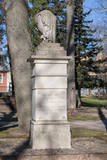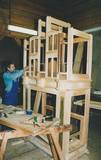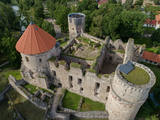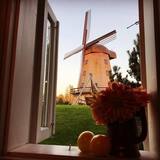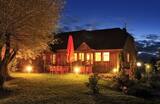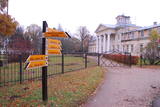| Nr | Name | Beschreibung |
|---|---|---|
|
A panoramic tour of Lithuania, Latvia, Estonia and Finland with highlights of nature experiences in the National parks and nature reserves. A variety of landscapes, nature attraction sites, birds and wild animals, forests and seashore. The tour also offers some cultural and historical insights. |
||
|
In 1877, Baron August von Pistohlkors, celebrating the merits of his ancestors in the foundation and development of Neibāde, ordered a monument to be erected in the park. After World War I, in the early 1930s, the monument was accidentally found during the cleaning of the bed of the River Ķīšupe. The monument was renovated by the Neibāde Aid and Improvement Society and officially reopened in 1933. The monument also suffered damage after World War II. Now the monument is restored and located in the park of the open-air stage. |
||
|
Der Bauernhof mit schönstem Garten im Kreis Viljandi bietet Urlaubsmöglichkeit sowohl für Hobbygärtner als auch Naturliebhaber, Im Garten wachsen viele interessante Pflanzen, ein Naturpfad führt zum Urtal Paistu. |
||
|
Die bedeutendste Periode der Stadt ist mit der Zeit von 1561 bis 1795 verbunden, als der Kreis von Jelgava dem Herzogtum von Kurland und Semgallen gehörte. Als Jelgava zur Residenz des Herzogs (1567) und zur Hauptstadt des Herzogtums (1616) wurde, blühte die Stadt schnell auf. Der höchste Punkt der Entwicklung war in der Regierungszeit des Herzogs Jacob. In der Regierungszeit der letzten zwei Herzoge – Ernst Johann von Biron und seines Sohnes Peters – wurde die Academia Petrina (1775) – die erste Hochschule in Lettland – gegründet, im Jahr 1816 wurde die Gesellschaft für Literatur und Kunst gegründet, im Jahr 1822 wurde die erste lettische Zeitung Latviešu Avīzes veröffentlicht, im Jahr 1802 wurde das erste Theatergebäude, aber im Jahr 1898 – das erste Museumsgebäude in Lettland gebaut. Im Jahr 1937 zog im Schloss von Jelgava die Lettische Landwirtschaftskammer ein, aber in zwei Jahren wurde die Landwirtschaftliche Akademie von Jelgava geöffnet. Im Sommer 1944 wurden fast die ganze historische Bebauung und die Kunstwerte der Stadt zerstört. Nach dem Zweiten Weltkrieg wurde Jelgava erneuert. Vor einer kurzen Zeit wurde auch der Turm der Heiligen Dreieinigkeitskirche erneuert, wo zurzeit eines der besten interaktiven Museen in Lettland (kinder- und familienfreundlich) eingerichtet ist. |
||
|
This is an open territory which is 3.5 km long and 2 km wide. It is located on the left bank of the Lielupe River between the village of Pavasari and the Odiņi homestead. The polder was established during the Soviet era to obtain farmland, and back then it was used very intensively. Today, it is slowly becoming overgrown, and despite this, this is one of the most important locations in Europe for corn-crakes. A gravel road crosses the polder from the North to the South, and this is an excellent place to hear the songs of the corn-crake. |
||
|
In Kännu Alpaca Farm you can see Peruvian alpacas, mammals with beautiful, soft coat which they are known for. While in this farm you can feed alpacas with food provided by the owners and pet them. You can also see goats, sheeps, rabbits and chickens. In the farm shop you can buy souvenirs and also products that are made of alpaca wool. Kännu Alpaca Farm is also suitable for family visits. |
||
|
1855, als einen Schiffahrtsweg getieft wurde, wurde im Haff unerwartet eine Bernsteinablagerung gefundet. In der Zeit zwischen 1860 und 1890 wurde dort 2250 Tonen Bernstein gewonnen, einbezogen einzigartige Bernsteingegenstände aus der Jungsteinzeit und der Bronsezeit. |
||
|
Die einzige Stelle in Lettland, an der man alte Orgeln erneuert und neue Orgeln, sowie die Drehorgeln baut. Die Meister erzählen den interessierten Gruppen über die Geschichte des Orgelbaus, die Prinzipien, einen Wirkmechanismus der Musikinstrumente. Die Werkstatt wurde 2004 in einem ehemaligen Stall des Pastorats eingerichtet. Der Besitzer und Leiter der Werkstatt ist Jānis Kalniņš. |
||
|
Im Burg-Komplex von Cesis trifft die Vergangenheit auf die Zukunft. |
||
|
The manor is in Basi in the Gudenieki Parish of Kuldīga District, some 20 km from the district centre. The manor was built in the 19th century, burned down in 1905, and then restored. A former residence for servants and an old magazine barn have survived. The surrounding park covers 4.5 ha, and the estate is a cultural and historical monument of local importance. The barn was fully reconstructed in 2009 and 2010 with co-financing from the European Union, and today it is the Basi Culture Centre. In 2019, there is to be an interactive exhibition about Suiti events in Gudenieki -- baptisms, weddings, funerals, etc. |
||
|
Bistro, Vergnügungspark, Leckerladen, Konditorei und Restaurant für einen Wochenend-Brunch am Ufer der Gauja, an der Landstraße A3. Lettische Küche: Kalte Suppe, Pilzsuppe, graue Erbsen, geschmortes Kraut, Fleischfrikadellen, Speisen aus einheimischen Fischen selbstgemachtes Eis und Kräutertees. Das besondere Gericht: Hausgemachte Torte von Rāmkalni. |
||
|
Ilze Kupča in Mārupe backt Kuchen und bewahrt dabei die Traditionen ihrer Großmutter. Sie hat mehrere Preise in lettischen Wettbewerben gewonnen. Kuchen und Zefir werden aus natürlichen Produkten hergestellt, die von lettischen Bauern, Heimwerker gekauft, selbst angebaut oder in den Wäldern selbst gesammelt werden. Nimmt individuelle Bestellungen an. Roggenspezialitäten – Zefir mit schwarzen Johannisbeeren und Apfel mit Roggenbrotbrösel, Preiselbeer–Karamellkuchen mit Roggenbrot. |
||
|
Bei der Führung kann man hausgemachtes Brot, Käse, Bier und Wildgerichte verkosten. Der alte Gemüsegarten und die Lindenallee laden zur Besichtigung ein, ebenso die im Hof gehaltenen Rot- und Dammhirsche und Mufflons. Kinder sind besonders an der Möglichkeit, Ziegen, Kaninchen und den Esel zu streicheln, interessiert. |
||
|
Es ist ein abseits gelegener Ort an der Grenze zwischen Lettland und Litauen, 5 km südwestlich von Nereta, den jeder Geschichtsliebhaber besuchen sollte. Warum? Einer der Gründe ist die Tatsache, dass die Getreidedarre des Landgutes (sie wird langsam erneuert) und der Darrofen für Getreide (ein Teil von den alten Holzteilen hat sich noch erhalten) sind die einzigen dieser Art in Lettland. Von dem Landgutkomplex haben sich noch der Pferdestall und das Haus der Diener erhalten, das heute bewohnt ist. Die Gebäude sind im 18. Jh. gebaut worden. Der Wirt des Landgutes kann über interessante Ereignisse erzählen, die mit der Geschichte dieses Ortes verbunden sind. |
||
|
You can go fishing on Lake Usma and then the lady of the house will cook tasty fish soup and smoked fish from what you catch. You can rent a boat, take part in fishing and casting of nets (in the winter, too), or take a cutter trip on the lake. You can also taste canned smoked bream and go horseback riding. |
||
|
Atrodas Burtnieka ezera austrumu krastā – uz ezera poldera dambja. Pavasara un rudens migrāciju laikā – laba putnu vērošanas vieta. Putni redzami ne tikai ezera piekrastē, bet arī poldera mitrajās pļavās. |
||
|
Nach der Durchquerung von Sigulda folgt der Waldweg dem Fluss Vējupīte zum Paradīzes-Hügel, wo eine steile Treppe hinunter in das alte Tal des Flusses Gauja und in die Schlucht des Flusses Vējupīte führt. Es schlängelt sich weiter über kleinere Wege durch Wiesen und überquert kleine Flüsse, deren Ufer Sandsteinaufschlüsse aufweisen. Die letzten sechs Kilometer dieses Abschnitts folgen einem kleineren Pfad entlang der Naturpfade von Līgatne. Auf diesem 5,5 km langen Weg können Sie einheimische Wildtiere und Vögel beobachten. Weiter auf dem Waldweg geht es die Hügel des alten Tals des Flusses Gauja hinauf, bevor es wieder hinunter in die tiefe Schlucht des Flusses Līgatne geht, wo sich das Dorf der ehemaligen Papierfabrik Līgatne befindet. Sie können dieses attraktive kleine Dorf erkunden, die Līgatne-Löffelfabrik, das Weingut und die Līgatne-Höhlen besuchen. Es gibt auch den Līgatne Net Park mit 4-7 m hohen Netzlabyrinthen zwischen den Baumwipfeln. Dieser Teil des Waldweges und des Gauja-Nationalparks ist durch einen allmählichen Übergang von verschiedenen Laubwäldern (Esche, Grauerle, Eiche, Birke, Linde) zu Nadelbeständen gekennzeichnet. |
||
|
Die Schänke befindet sich am Rande der Straße Murjani – Limbazi (P9). Sie ist auf den Fundamenten der Mühle des Landgutes gebaut worden, dabei wurde das Mühlenrad erhalten. Die Schänke arbeitet mit den lokalen Bauern zusammen. Lettische Küche: Steinpilzsuppe, Gerstengrütze mit Fleisch, Gerstenfladen, Grützwurst mit Preiselbeersoße, dünne Pfannkuchen mit Marmelade, Kartoffelpfannkuchen, gebratene Flunder oder gebratener Zander, geschichtetes Roggenbrot-Dessert. Das besondere Gericht: Geschmortes Kaninchen und gefülltes Truthahnfilet. |
||
|
Die evangelisch-lutherische Kirche von Krimulda wird als eines der ältesten Gotteshäuser von Lettland angesehen. Die Anfänge der Kirche sind im Anfang des 13. Jhs. gleich nach der Eroberung von Kubesele zu suchen, später wurde die Kirche mehrmals umgebaut. Neben der Kirche ist das Labyrinth für Meditationen Lilijas zieds (Lilienblüte) eingerichtet. Als im Jahr 1217 im Kampf von Viljandi der livische Häuptling Kaupo gefallen ist, wurden seine Aschen laut Erzählungen in der Kirche beigesetzt. Als die Grabstätte von Kaupo wird im Volke ein kleiner Hügel neben dem kleinen Fluss Runtiņupīte (Runtiņš) genannt, an dessen rechten Ufer sich die ungefähr 7 m lange und künstlich gegrabene Höhle Kubeseles ala (Runtiņala) befindet. Am linken Ufer des Flusses Runtiņupīte erhebt sich der Burgberg von Kubesele. An der Kirche beginnt der Naturpfad von Kubesele. Wenn man den Pfad folgt, gelangt man bis zum Fluss Gauja, an dessen Ufer der Stein Lielais (Runtiņa) akmens liegt. Hier kann man auch die von den Flößern von Gauja aufgestellten Ankerklötze besichtigen. Die mittelalterliche Burg von Krimulda (4 km östlich von der Kirche von Krimulda) wurde in der zweiten Hälfte des 13. Jhs. an der Stelle gebaut, wo der Grundufer des Urstromtales von Gauja von dem Tal Vikmestes grava durchgespaltet wird. Die Burg, in der das Domkapitel von Riga – der Rat der Erzbischöfe von Riga – gewirtschaftet hat, war ein eindrucksvolles Gebäude, dessen breiter Innenhof von einer 1,5 m dicken Schutzmauer eingeschlossen war. Im Jahr 1601 hat der schwedische Feldherr Heinrich von Lieven die Burg beim Zurückziehen gesprengt. Heute kann man auf dem von den Wäldern bewachsenen Hügel einige Burgreste besichtigen. Neben den Burgresten befindet sich die Luftseilbahn und beginnt der Serpentinweg von Krimulda. Unweit befindet sich das Landgut von Krimulda, das in den schriftlichen Quellen zum ersten Mal schon im 15. Jh. erwähnt worden ist. Das heutige Schloss des Landgutes wurde im 19. Jh. im Neoklassizismus (der Inhaber – Baron on Lieven) gebaut. In den 1920er Jahren gelang das Schloss nach der Enteignung im Eigentum des Roten Kreuzes, das dort ein Sanatorium für Kinder eingerichtet hat. Heute befindet sich in diesem Schloss das Rehabilitationskrankenhaus Krimulda, aber von den wirtschaftlichen Häusern des Landgutes haben sich die Ställe, das Haus der Diener und der Verwalter und das sogenannte Haus der Schweiz, sowie der Park erhalten. Hier werden thematische Führungen angeboten. Wenn man eine Bootsfahrt auf dem Fluss Gauja unternimmt, kann man in der Nähe die 15 m hohe Steilwand Velnalas klintis (Felsen der Teufelshöhle) besichtigen. Die Steilwand kann man sehr gut auch aus dem anderen – dem linken – Ufer des Flusses Gauja besichtigen, wo ein Picknickplatz eingerichtet ist. In der Mitte der Steilwand befindet sich die ungefähr 19 m tiefe und 4,7 m hohe Höhle Velnala (Teufelshöhle) von Krimulda. Wenn wir von dieser Steilwand das rechte Grundufer des Flusses Gauja Richtung Turaida am unten gehen, können wir die Sandstein-Steilwand von Piķene besichtigen. Unten an der Steilwand ist der ungefähr 1 km lange Biberpfad von Piķene eingerichtet. Am Rande des Pfades befindet sich die 5 m lange Höhle Mazā Velna ala (die kleine Teufelshöhle) mit der Quelle Gudrības avotiņš (Quelle der Weisheit), sowie die genauso lange Höhle Aunapieres ala. Hier kann man auch einige zugewachsene Nebenflüsse sehen. |
||
|
Ekskursijas sākumā apmeklējiet Enerģētikas muzeja ekspozīciju Pļaviņu hidroelektrostacijā, kur iespējams iepazīties ar unikālās būves un lielākās elektroenerģijas ražotnes Baltijā celtniecības vēsturi un darbības nozīmīgākajiem notikumiem. Pēc tam apmeklējiet Skrīveru pārtikas kombinātu, kurā iespējams iegādāties gardās konfektes un doties ekskursijā. Tālāk - Skrīveru mājas saldējums ar stāstījumu par saldējuma gatavošanu un degustācija. Brauciena noslēgumā dodieties uz savvaļas dzīvnieku dārzu, kur dzīvo ~ 50 dambrieži un Skotijas savvaļas govis. |
||

